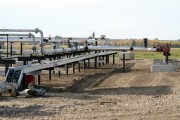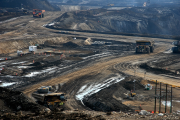Imagine going into a bank to apply for pre-approval for a mortgage. You don't have a steady income, so instead you present 10 cheques. They're one-time-only payments from anonymous sources and they don't amount to much of a down payment.
The bank would tell you to go home, get a steady job and come back when you've got long-term employment. Until then, you're wasting their time.
This is the way things work, right? Not in some cases. This scenario is essentially what Enbridge has presented to a federal joint review panel considering its application to build the Northern Gateway oilsands pipeline from Alberta to Kitimat, on B.C.'s North Coast.
Only, in this case we're not just talking about wasting the time of a mortgage officer — we're talking about all of the affected First Nations and communities along the pipeline route.
You see, Enbridge is the first pipeline of its kind to be considered by regulators before having long-term shipping agreements in place. Basically, nobody has signed up to actually ship oil through the pipeline or receive it at the other end.
What Enbridge does have is what it calls "funding participants" — 10 top-secret stakes in the pipeline for $10 million each. But according to a new report released by the Pembina Institute on Thursday, that confidential cash doesn't necessarily translate to oil in a pipeline.
The report exposes uncertain demand for the pipeline and shines a spotlight on oil pipeline overcapacity in North America.
Not only is Enbridge lacking shipper commitments, but its Northern Gateway application is also the first of its kind not to provide a refinery-specific demand analysis. This is particularly peculiar given that refineries need to be specially equipped to handle diluted bitumen, which accounts for more than half of the oilsands products Enbridge says it will transport in its pipeline.
Adding to doubt about whether there is sufficient demand for the pipeline is Pembina's new analysis that shows that if both the Northern Gateway and TransCanada Keystone XL pipelines were approved and in operation by 2016 (a core assumption of Enbridge's application), there would be 41 per cent excess capacity — or two million extra barrels per day — in the export pipeline system.
Even pipeline companies themselves consider 25 per cent excess capacity optimal, which is why Enbridge has been taken to court previously by Suncor and Imperial for building what they argue is too much pipeline capacity to the United States.
In the past two years, concerns about overcapacity contributed to decisions to shelve plans for almost 1.5 million barrels per day in export pipelines. Meanwhile, Enbridge is applying to load up 225 oil tankers each year, putting the pristine Great Bear Rainforest at risk of a catastrophic oil spill — all while we have a North American export pipeline system awash in excess capacity.
Not making a lot of sense?
You're probably wondering why, considering all of this, Enbridge is applying to build Northern Gateway and why the joint review panel, appointed by the federal government, would even consider reviewing a project with such unprecedented lack of proof of commercial demand.
Documents we retrieved through Access to Information legislation help complete the picture.
The correspondence reveals the Government of Canada is pursuing an orchestrated strategy to undermine U.S. efforts to combat climate change by doing things such as partnering with industry to fight U.S. efforts designed to reduce greenhouse gas emissions from high-carbon fuels such as oilsands — rather than ensuring Canadian oil companies improve their performance to comply with the law. One diplomat was recorded describing their job as ensuring the "oil keeps aflowing."
It just so happens that another way to fight U.S. climate policy is to wield the threat of exports to Asia. And that appears to be what the Northern Gateway pipeline is all about — at the cost of British Columbians, 80 per cent of whom have indicated they're opposed to opening B.C.'s northern waters to giant oil tankers.
Enbridge is not respecting the time and resources of regulators and British Columbians with its incomplete application. If the panel continues to consider this project despite the uncertainties and lack of information provided by Enbridge, it will establish a new precedent that stands to erode the integrity of the regulatory review process.
That should not be allowed to happen. Instead, Enbridge should be sent back to the drawing board.
Nathan Lemphers is a policy analyst for the Pembina Institute, a national sustainable energy think tank.





